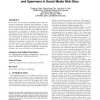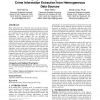1759 search results - page 132 / 352 » Using term informativeness for named entity detection |
IEEEARES
2010
IEEE
15 years 3 months ago
2010
IEEE
Spyware represents a serious threat to confidentiality since it may result in loss of control over private data for computer users. This type of software might collect the data and...
CIKM
2009
Springer
15 years 1 months ago
2009
Springer
Social media are becoming increasingly popular and have attracted considerable attention from spammers. Using a sample of more than ninety thousand known spam Web sites, we found ...
EUROPKI
2004
Springer
15 years 3 months ago
2004
Springer
Abstract. At present, network users have to manage a set of authentication credentials (usually a username/password pair) for every service with which they are registered. Single S...
DGO
2008
14 years 11 months ago
2008
Much information that could help solve and prevent crimes is never gathered because the reporting methods available to citizens and law enforcement personnel are not optimal. Dete...
BMCBI
2010
14 years 10 months ago
2010
Background: Primer and probe sequences are the main components of nucleic acid-based detection systems. Biologists use primers and probes for different tasks, some related to the ...


